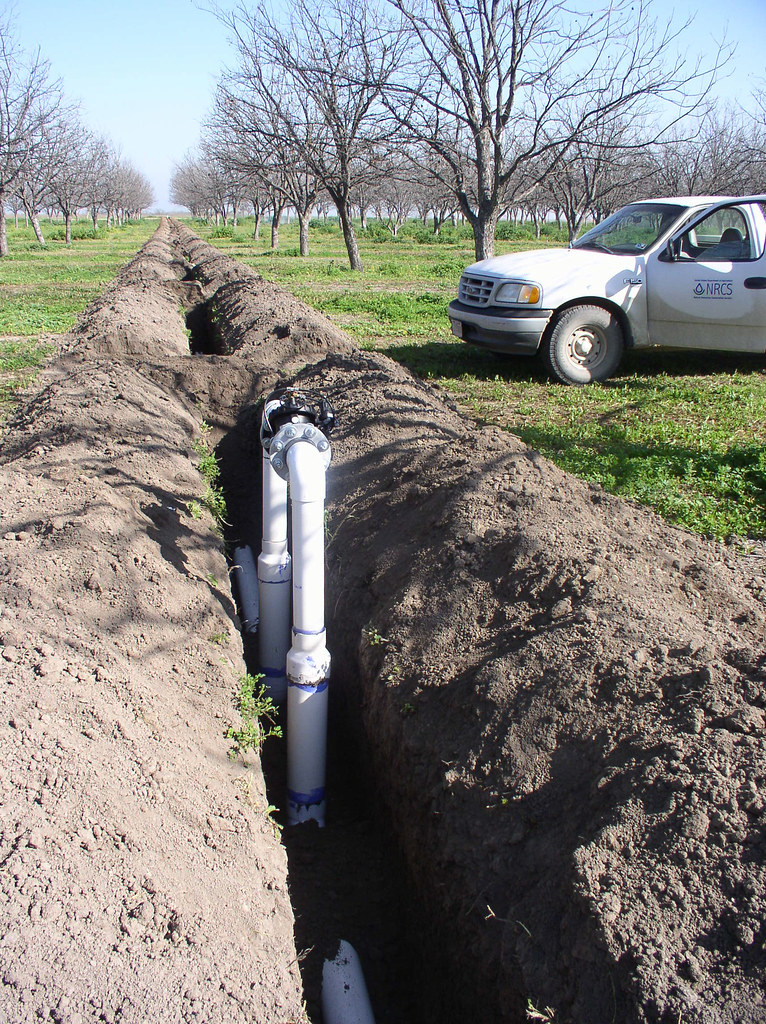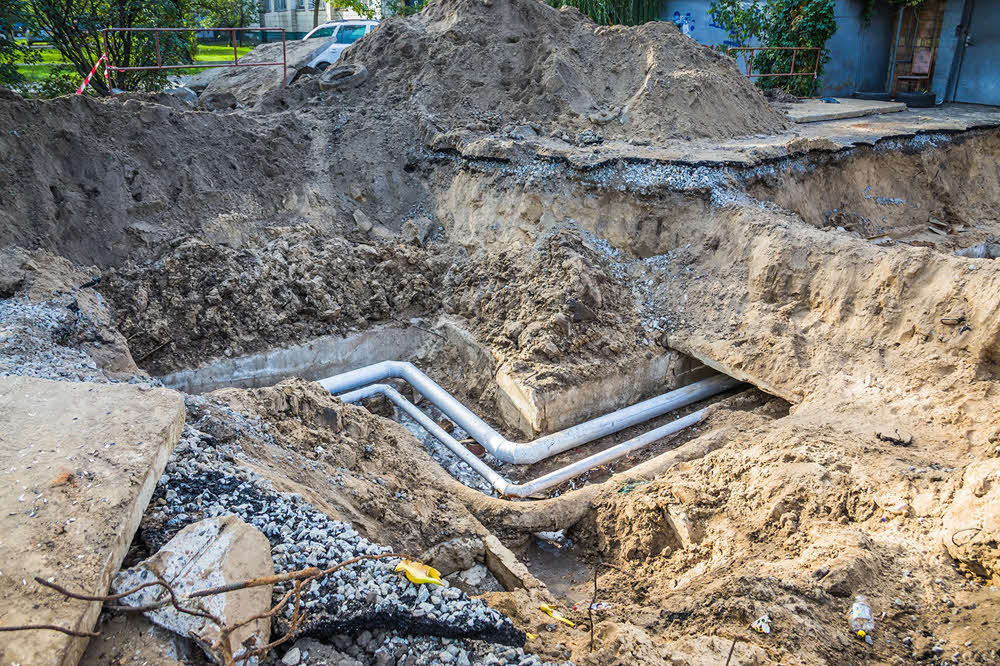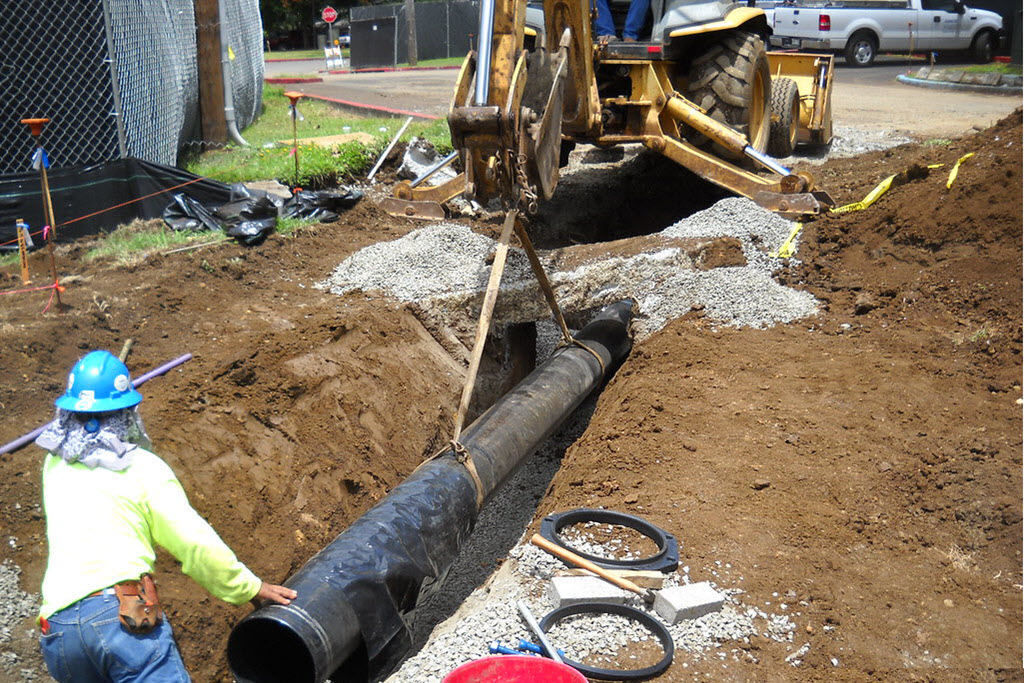Trenching Water Line Servicesin Romeo MI
Trenching for Water Lines to Ensure Reliable Water Flow
We Are Locally Owned & Operated For Over 37 Years
Contact Us Today!
We Serve Businesses In And Around The Following Cities:
About Trenching Water Line Services
Introduction to Trench for Water Line in Commercial Properties
When it comes to the infrastructure in commercial properties, underground water lines play an essential role. They transport clean water from the main source to various parts of the property efficiently. That’s where the necessity for trench for water line arises. Done correctly, this process doesn’t just ensure the consistent flow of water. It also helps maintain the integrity of the property and provides a long-term, cost-effective solution for water transportation. Welcome to a comprehensive guide that digs into the process, benefits, and real-world applications of trench for water line in the city of Romeo.
Understanding the Trench for Water Line Process
The process of creating a trench for the water line involves a calculated exercise of digging the ground where the water line would run. This task isn’t as straightforward as it sounds. In most cases, it involves precise engineering and expertise to ensure that the water line won’t interfere with nearby utilities, structures, or foundations. In many instances, firms such as D&J Contracting handle the trenching process in the city of Romeo.
This process begins with marking the area for the trench and then using specialized equipment to dig. The depth and width depend on the size and type of pipes being installed. Once the trench is dug, a bed of straight sand or gravel is placed at the bottom before the water service lines are installed. The earth dug out is then gradually replaced, compacting it to prevent the line from dislodging. Trench for water line requires careful planning, execution, and knowledge of local building codes to ensure the water main installation is compliant and efficient.
The Substantial Benefits of Properly Installed Trench for Water Line
Commercial properties stand to gain numerous advantages from installing a well-planned water service line. For starters, trenching protects water lines from potential damage caused by heavy traffic or accidental digging by reducing the risk of pipe exposure. Secondly, it can optimize the plumbing design, enhancing the consistency of water flow throughout the building. Crucially, trenching for a water line helps ensure that your water main installation remains compliant with Romeo’s city guidelines, preventing potential non-compliance penalties.
Another significant benefit is the potential for cost savings over time. With a well-executed trench for a water line, commercial properties could sidestep the hefty repair costs associated with line damage or inefficiency. By opting for expert services such as those offered by D&J Contracting, commercial property owners and operators turn what can be a tasking and complicated process into a streamlined, value-adding asset.
Real-World Applications of Trench for Water Line
Trenching for water lines has plenty of practical applications in real-world scenarios. Take, for example, a new commercial property going up in downtown Romeo. By incorporating a well-planned trench for water line during the construction phase, the developers ensure a consistent, dependable water supply to the entire building. It could also significantly reduce the time, cost, and inconvenience of running a new water line post-construction.
For existing properties wishing to revamp their water systems or accommodate new additions, running a new water line via trenching offers an efficient solution. Let’s assume a commercial property intends to build a new wing. Instead of tampering with the existing water service line, a new line could be run from the main source to the new wing. Consequently, it ensures the water supply to the existing infrastructure is undisturbed while adequately catering to the new addition.
In larger commercial properties such as shopping complexes, office parks, or industrial sites, efficiency matters. These properties often serve thousands of people and processes every day, and a consistent, dependable water supply is non-negotiable. Trenching for water lines provides the required level of service while offering flexibility in design and future expansion. This benefit is especially crucial in the bustling city of Romeo, where prompt service, quality, and consistency can make the difference between a thriving commercial property and one that fails to meet its potential.
A Final Reflection on Trench for Water Line
As this guide illustrates, creating a trench for water line in commercial properties is more than just digging a hole and laying pipes. It’s an intricately planned and carefully executed process crucial to any property’s overall functionality and operational efficiency, especially in a city like Romeo.
Working with experienced, reliable experts like D&J Contracting can ensure that your water line installation goes smoothly and efficiently, minimizing disruption and prospective complications. By investing in such services, commercial property owners and managers lay the groundwork for dependable service, impressive cost savings, and peace of mind for the long run.
Trench for water line isn’t just a construction feature; it’s an investment in the property’s future functionality and an essential component in maintaining the city’s health and vitality. This intricate process is a testament to the vital role infrastructure plays in our urban landscapes—a role that each one of us, as property owners, managers, or residents, should recognize, respect, and treasure.
Trenching Water Line Services Gallery


Call Us Today to receive your Free Quote for
Trench For Water Line in Romeo
Serving: Romeo, Michigan

About Romeo, Michigan
A settlement here was originally occupied by the indigenous Chippewa (Ojibwe), an Algonquian-speaking people who were part of a large language family of tribes extending to the Atlantic Coast. Those tribes around the Great Lakes are thought to have migrated to this area by the 12th century.
The early European-American settlers in this area referred to the Chippewa settlement as “Indian Village”. In the 1820s and 1830s more migrant European-American families began to settle in the area, building homes and establishing businesses. They renamed the community “Hoxie’s Settlement”, after a man who opened an inn on Main Street. In 1839, Hoxie’s Settlement became incorporated and was renamed as the village of Romeo. The name was suggested by the wife of local merchant Nathaniel Taylor because it was “short, musical, classical and uncommon.” Romeo celebrated its 175th anniversary on March 9, 2013.
Romeo once served as a trading center for the timber industry, and had many mills processing lumber from the region. Many wealthy timber families resided there. Dozens of stately Victorian mansions survive. Romeo is distinct in the area for having a fairly robust, traditional downtown, which has never suffered a major fire. Because of this, some stores and restaurants downtown have features such as original tin ceilings from the Civil War. In the early 20th century, Romeo was the site of an early business devoted to the new automobile industry: the Detroit Auto Vehicle Company operated here from 1904 until 1908.
The village is in northwestern Macomb County, situated at the southeast corner of Bruce Township, with a portion extending south into Washington Township. Armada Township is adjacent to the east and Ray Township to the southeast. M-53 passes through the east side of the village, leading north 16 miles (26 km) to Imlay City and south 30 miles (48 km) to the eastern side of Detroit.
According to the United States Census Bureau, the village of Romeo has a total area of 2.05 square miles (5.31 km), of which 0.002 square miles (0.005 km), or 0.10%, are water. East Pond Creek crosses the easternmost part of the village, flowing east to the North Branch of the Clinton River, part of the Lake St. Clair watershed.
| Census | Pop. | Note | %± |
|---|---|---|---|
| 1850 | 330 | — | |
| 1880 | 1,629 | — | |
| 1890 | 1,637 | 0.5% | |
| 1900 | 1,580 | −3.5% | |
| 1910 | 1,787 | 13.1% | |
| 1920 | 2,102 | 17.6% | |
| 1930 | 2,283 | 8.6% | |
| 1940 | 2,627 | 15.1% | |
| 1950 | 2,985 | 13.6% | |
| 1960 | 3,327 | 11.5% | |
| 1970 | 4,012 | 20.6% | |
| 1980 | 3,509 | −12.5% | |
| 1990 | 3,520 | 0.3% | |
| 2000 | 3,721 | 5.7% | |
| 2010 | 3,596 | −3.4% | |
| 2020 | 3,767 | 4.8% | |
| U.S. Decennial Census | |||
As of the census of 2010, there were 3,596 people, 1,501 households, and 979 families residing in the village. The population density was 1,780.2 inhabitants per square mile (687.3/km). There were 1,659 housing units at an average density of 821.3 per square mile (317.1/km). The racial makeup of the village was 91.9% White, 3.8% African American, 0.2% Native American, 0.5% Asian, 1.1% from other races, and 2.6% from two or more races. Hispanic or Latino people of any race were 5.7% of the population.
There were 1,501 households, of which 32.2% had children under the age of 18 living with them, 46.2% were married couples living together, 14.9% had a female householder with no husband present, 4.1% had a male householder with no wife present, and 34.8% were non-families. 30.8% of all households were made up of individuals, and 13.6% had someone living alone who was 65 years of age or older. The average household size was 2.36 and the average family size was 2.96.
The median age in the village was 40.9 years. 23.5% of residents were under the age of 18; 7.7% were between the ages of 18 and 24; 24.1% were from 25 to 44; 29.4% were from 45 to 64; and 15.3% were 65 years of age or older. The gender makeup of the village was 46.4% male and 53.6% female.
As of the census of 2000, there were 3,721 people, 1,528 households, and 993 families residing in the village. The population density was 1,842.8 inhabitants per square mile (711.5/km). There were 1,605 housing units at an average density of 794.9 per square mile (306.9/km). The racial makeup of the village was 92.66% White, 4.35% African American, 0.16% Native American, 0.40% Asian, 0.11% Pacific Islander, 0.67% from other races, and 1.64% from two or more races. Hispanic or Latino people of any race were 2.74% of the population.
There were 1,528 households, out of which 33.3% had children under the age of 18 living with them, 48.2% were married couples living together, 13.5% had a female householder with no husband present, and 35.0% were non-families. 31.3% of all households were made up of individuals, and 13.2% had someone living alone who was 65 years of age or older. The average household size was 2.40 and the average family size was 3.04.
In the village, the population was spread out, with 26.1% under the age of 18, 8.2% from 18 to 24, 30.1% from 25 to 44, 21.4% from 45 to 64, and 14.2% who were 65 years of age or older. The median age was 36 years. For every 100 females, there were 87.2 males. For every 100 females age 18 and over, there were 82.5 males.
The median income for a household in the village was $48,015, and the median income for a family was $60,179. Males had a median income of $51,875 versus $27,696 for females. The per capita income for the village was $22,588. About 3.2% of families and 3.9% of the population were below the poverty line, including 6.5% of those under age 18 and 3.9% of those age 65 or over.
The government of the village of Romeo consists of elected and appointed officials. The elected officials include six council members, one president, treasurer and clerk. The appointed officials include the Chief of Police, Department of Public Works Director, and Village Administrator. Currently, the elected clerk also holds the appointed position of Village Administrator. The day-to-day operations of the village are handled by the Clerk/Administrator.
Since the turn of the 21st century, Romeo has worked to upgrade its infrastructure. It has improved the streetscape on Van Dyke Avenue, the main road through the village, and installed a new water tower. It had earlier established one of the few wastewater treatment plants in the region. While most of the metropolitan region receives water and sewage service from the City of Detroit, Romeo independently sustains its own supply of water and manages treatment of village sewage. This was especially valuable during the blackout that occurred throughout the entire northeastern United States on August 14, 2003. Romeo was one of the few areas in the Detroit metropolitan area to have clean running water. More recent infrastructure improvements include a complete renovation of the village water system, and replacement of all the sidewalks throughout the village.
Call Us Today to receive your Free Quote for
Trench For Water Line in Romeo
Related Services in Romeo, Michigan
We Serve Businesses In The Following Zip Codes:
48007, 48015, 48021, 48026, 48035, 48036, 48038, 48042, 48043, 48044, 48045, 48046, 48047, 48048, 48050, 48051, 48066, 48071, 48080, 48081, 48082, 48083, 48084, 48085, 48088, 48089, 48090, 48091, 48092, 48093, 48098, 48099, 48225, 48230, 48236, 48310, 48311, 48312, 48313, 48314, 48315, 48316, 48317, 48318, 48397